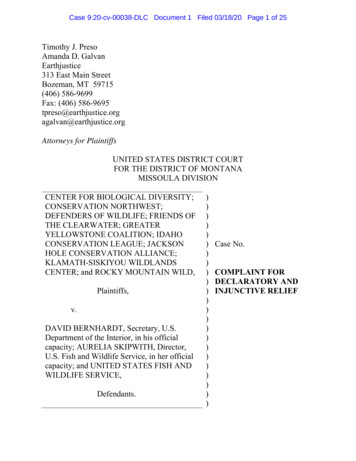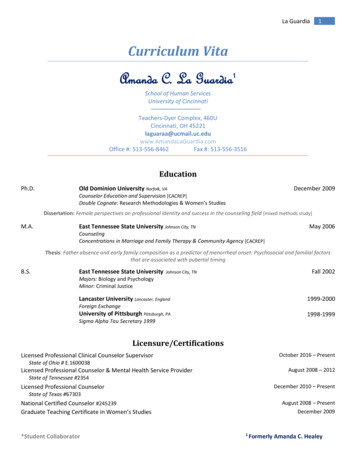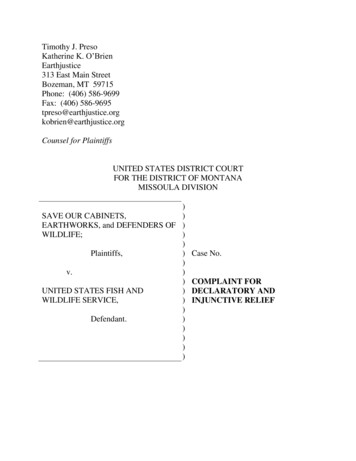
Transcription
Case 9:20-cv-00038-DLC Document 1 Filed 03/18/20 Page 1 of 25Timothy J. PresoAmanda D. GalvanEarthjustice313 East Main StreetBozeman, MT 59715(406) 586-9699Fax: (406) e.orgAttorneys for PlaintiffsUNITED STATES DISTRICT COURTFOR THE DISTRICT OF MONTANAMISSOULA DIVISIONCENTER FOR BIOLOGICAL DIVERSITY;CONSERVATION NORTHWEST;DEFENDERS OF WILDLIFE; FRIENDS OFTHE CLEARWATER; GREATERYELLOWSTONE COALITION; IDAHOCONSERVATION LEAGUE; JACKSONHOLE CONSERVATION ALLIANCE;KLAMATH-SISKIYOU WILDLANDSCENTER; and ROCKY MOUNTAIN WILD,Plaintiffs,v.DAVID BERNHARDT, Secretary, U.S.Department of the Interior, in his officialcapacity; AURELIA SKIPWITH, Director,U.S. Fish and Wildlife Service, in her officialcapacity; and UNITED STATES FISH ANDWILDLIFE SERVICE,Defendants.)))))))))))))))))))))))Case No.COMPLAINT FORDECLARATORY ANDINJUNCTIVE RELIEF
Case 9:20-cv-00038-DLC Document 1 Filed 03/18/20 Page 2 of 25INTRODUCTION1.This case challenges the United States Fish and Wildlife Service’s(“FWS”) failure to meet its mandatory statutory deadline to make a finaldetermination on the proposed listing of the distinct population segment of theNorth American wolverine occurring in the contiguous United States as athreatened species under the Endangered Species Act (“ESA”).2.This Court last examined FWS’s conduct regarding the wolverine in a2014 case challenging FWS’s decision to withdraw its proposed rule listing thewolverine in the lower-48 states as threatened under the ESA. In that case, thisCourt held that FWS had illegally withdrawn the proposed rule and directed FWSto take action in making a listing determination for the wolverine as expeditiouslyas possible.3.Nonetheless, in the more than three years that have passed since thisCourt’s decision, FWS has failed to render a final decision on the wolverine listing,in violation of this Court’s 2014 direction and the ESA. 16 U.S.C. §1533(b)(6)(A)(i), (B)(iii). The ESA authorizes this Court to order FWS to performsuch unlawfully withheld agency action. Id. § 1540(g). Accordingly, plaintiffsnow return to this Court seeking relief from FWS’s continuing unlawful conduct.1
Case 9:20-cv-00038-DLC Document 1 Filed 03/18/20 Page 3 of 25JURISDICTION, VENUE AND ADMINISTRATIVE REMEDIES4.This action is brought pursuant to the Endangered Species Act, 16U.S.C. § 1540(g)(1)(C) (failure of Secretary to perform nondiscretionary duty),which waives the defendants’ sovereign immunity. This Court has jurisdictionover plaintiffs’ claims pursuant to 28 U.S.C. § 1331 (federal question) and 16U.S.C. § 1540(g)(1)(C) (ESA citizen-suit provision), and may issue a declaratoryjudgment and further relief pursuant to 16 U.S.C. § 1540(g)(1)(C) and 28 U.S.C.§§ 2201-02.5.Venue is proper in this District under 28 U.S.C. § 1391 because asubstantial part of the ESA violations alleged in this complaint occurred in thisDistrict and a significant number of the remaining wolverines impacted by theFWS’s unlawful conduct are located in this District.6.Plaintiffs provided defendants with 60 days’ written notice ofplaintiffs’ intent to sue on January 16, 2020, as required by 16 U.S.C. § 1540(g)(2).PARTIES7.Plaintiff Center for Biological Diversity (the “Center”) is a nonprofitorganization dedicated to the preservation, protection and restoration ofbiodiversity, native species and ecosystems. The Center was founded in 1989 andis based in Tucson, Arizona, with offices throughout the country. The Centerworks through science, law, and policy to secure a future for all species, great or2
Case 9:20-cv-00038-DLC Document 1 Filed 03/18/20 Page 4 of 25small, hovering on the brink of extinction. The Center is actively involved inspecies and habitat protection issues and has more than 74,000 membersthroughout the United States and the world. The Center brings this action on itsown institutional behalf and on behalf of its members. Many of the Center’smembers and staff reside in, explore and enjoy mountain landscapes in the lower48 states occupied by wolverines.8.Plaintiff Conservation Northwest is a non-profit conservationorganization based in Bellingham, Washington. Conservation Northwest wasfounded in 1988 and now has more than 15,000 members and supporters.Conservation Northwest seeks to maintain the ecological integrity of theNorthwest’s wildlands and advocates for protection of imperiled wildlife such asthe lynx, the fisher, and the wolverine.9.Plaintiff Defenders of Wildlife (“Defenders”) is a non-profitconservation organization based in Washington, D.C., with offices across thecountry. Defenders has more than 1 million members and supporters across thenation, many of whom reside within the historic and current range of thewolverine. Defenders is dedicated to protecting and restoring all native wildanimals and plants in their natural communities. Defenders has invested time andresources protecting the wolverine and its habitat, including advocating formonitoring and conservation of the species, and for listing the wolverine as an3
Case 9:20-cv-00038-DLC Document 1 Filed 03/18/20 Page 5 of 25endangered or threatened species under the ESA. In addition, Defenders regularlypublishes information regarding species, including the wolverine, for the use of itsmembers and the public.10.Plaintiff Friends of the Clearwater (“Friends”) is a non-profitconservation organization based in Moscow, Idaho. Friends is dedicated toprotecting the National Forests and public lands of the Greater Salmon-SelwayEcosystem in central Idaho. Friends has actively advocated for protection of thewolverine by sponsoring free public-education presentations about the wolverine inIdaho, publishing articles about the wolverine in its newsletter, gatheringwolverine sightings information from the public agencies in the region, andparticipating in public-involvement processes that affect wolverines and theirhabitat.11.Plaintiff Greater Yellowstone Coalition (“GYC”) is a conservationorganization dedicated to protecting and restoring the Greater YellowstoneEcosystem and the unique quality of life it sustains. Formed in 1983, GYC is anon-profit corporation and has approximately 90,000 supporters. Central toGYC’s mission is maintaining the Greater Yellowstone Ecosystem’s signaturepopulations of rare and imperiled wildlife, including the wolverine.12.Plaintiff Idaho Conservation League (“ICL”) is a non-profitconservation organization based in Boise, Idaho, that seeks to preserve Idaho’s4
Case 9:20-cv-00038-DLC Document 1 Filed 03/18/20 Page 6 of 25clean water, wilderness and quality of life through citizen action, public education,and professional advocacy. ICL was founded in 1973 and today has approximately10,000 members. ICL seeks to preserve Idaho’s wildlife habitat for a variety ofspecies, including the wolverine.13.Plaintiff Jackson Hole Conservation Alliance is a non-profitconservation advocacy organization based in Jackson, Wyoming with more than2,000 supporters. The Jackson Hole Conservation Alliance works to protect thewildlife, wild places, and community character of Jackson Hole by empoweringthe whole community to live in balance with nature.14.Plaintiff Klamath-Siskiyou Wildlands Center (“KS Wild”) is a non-profit organization incorporated in Oregon with offices in Ashland and Williams,Oregon. KS Wild has 3,500 members in more than 10 states, with most membersconcentrated in southern Oregon and northern California. KS Wild advocates forthe forests, wildlife, and waters of the Rogue and Klamath Basins, and works toprotect and restore the extraordinary biological diversity of the Klamath-Siskiyouregion of southwest Oregon and northwest California. KS Wild usesenvironmental law, science, education, and collaboration to help build healthyecosystems and sustainable communities.15.Plaintiff Rocky Mountain Wild is a non-profit wildlife conservationorganization based in Denver, Colorado, and has more than 7,600 members and5
Case 9:20-cv-00038-DLC Document 1 Filed 03/18/20 Page 7 of 25supporters. Rocky Mountain Wild works to protect the biological diversity of theRocky Mountain West, and monitors the status of more than 500 species andconserves core habitats that sustain wildlife and native plants.16.Plaintiffs’ members and staff seek to observe, photograph, and studythe wolverine and/or signs of the wolverine’s presence in its native habitat.Members and staff of the plaintiff organizations also live and/or recreatethroughout the current and historic range of the wolverine. Plaintiffs use andenjoy, on a continuing and ongoing basis, the habitat of the wolverine and thelarger ecosystem upon which it depends. Plaintiffs derive aesthetic, recreational,scientific, inspirational, educational, and other benefits from these activities.17.An integral aspect of plaintiffs’ interest in the wolverine is theexpectation and knowledge that the wolverine is present, healthy, and wild in itsnative range. Members of each of the plaintiff groups have conservation andaesthetic interests in the continued existence of wolverines in the westernlandscape in part because the reclusive wolverine is a living symbol of our nation’sremaining wilderness. As the pioneering American wildlife biologist andconservationist Olaus Murie once wrote, “I wonder if there is another inhabitant ofnorthern wilderness that so excites the imagination.” Olaus, Murie, A Field Guideto Animal Tracks 66 (2d ed. 1974). Murie described coming upon a wolverinetrail in an early winter snowfall: “Merely seeing those tracks in the snow made it a6
Case 9:20-cv-00038-DLC Document 1 Filed 03/18/20 Page 8 of 25red-letter day.” Id. at 68. Plaintiffs have an interest in preserving the possibility ofsuch experiences and activities in the future. Plaintiffs’ interest in the wolverine isentirely dependent on the continued existence of a healthy wolverine population inthe wild. Plaintiffs’ members and staff have participated in efforts to protect andpreserve the habitat essential to the continued survival of the wolverine.18.The legal violation alleged in this complaint causes direct injury to theaesthetic, conservation, recreational, inspirational, educational, and wildlifepreservation interests of the plaintiffs and members of the plaintiff organizations.These are actual, concrete injuries to plaintiffs, caused by defendants’ failure tocomply with the ESA and its implementing regulations and policies. Theseinjuries would be redressed by the relief requested in this complaint. Plaintiffshave no other adequate remedy at law.19.Defendant David Bernhardt is the United States Secretary of theInterior. In that capacity, Secretary Bernhardt has supervisory responsibility overFWS. The Secretary of the Interior is the federal official vested with responsibilityfor properly carrying out the ESA with respect to terrestrial mammals such as thewolverine. Defendant Bernhardt is sued in his official capacity.20.Defendant Aurelia Skipwith is the Director of the United States Fishand Wildlife Service. Defendant Spikwith is sued in her official capacity.7
Case 9:20-cv-00038-DLC Document 1 Filed 03/18/20 Page 9 of 2521.Defendant United States Fish and Wildlife Service is a federal agencywithin the Department of Interior. FWS is responsible for administering the ESAwith respect to terrestrial wildlife such as wolverines, including species listingdeterminations under ESA Section 4.THE ENDANGERED SPECIES ACT22.The ESA was enacted to “provide a program for the conservation of endangered species and threatened species” and to “provide a means wherebythe ecosystems upon which endangered species and threatened species depend maybe conserved.” 16 U.S.C. § 1531(b).23.The ESA is a call to species protection: a commitment, in the words ofthe U.S. Supreme Court, “to halt and reverse the trend toward species extinction—whatever the cost” by rejecting the “economic growth and developmentuntempered by adequate concern and conservation” that gave this country itslegacy of extinctions. Tennessee Valley Auth. v. Hill, 437 U.S. 153, 154 (1978);see 16 U.S.C. § 1531(a)(1).24.To be protected by the ESA’s conservation program, a species mustfirst be listed under the ESA as endangered or threatened. The ESA defines“endangered species” as “any species which is in danger of extinction throughoutall or a significant portion of its range.” Id. § 1532(6). A “threatened species” is“any species which is likely to become an endangered species within the8
Case 9:20-cv-00038-DLC Document 1 Filed 03/18/20 Page 10 of 25foreseeable future throughout all or a significant portion of its range.” Id. §1532(20). The term “species” is defined to include “any distinct populationsegment of any species of vertebrate fish or wildlife which interbreeds whenmature.” Id. § 1532(16). Under these definitions, FWS can list as endangered orthreatened a distinct population segment of a vertebrate species.25.To achieve the goal of conserving threatened and endangered species,section 4 of the ESA requires the Secretary of the Interior to determine whether aspecies is threatened or endangered, 16 U.S.C. § 1533(a)(l), designate criticalhabitat for the species, id. § 1533(a)(3), and promulgate a recovery plan for thespecies, id. § 1533(f).26.During the listing process, the ESA sets mandatory deadlines foragency action. One such deadline is that after publishing a proposed rule, the ESArequires FWS to publish a final rule or withdraw the proposed rule within one year,16 U.S.C. § 1533(b)(6)(A)(i), except that, upon finding “substantial disagreementregarding the sufficiency or accuracy” of available scientific data, the Secretarymay extend the period for no more than 6 months for the purpose of “solicitingadditional data,” id. § 1533(b)(6)(B)(i). These deadline requirements are echoed inthe ESA’s implementing regulations. 50 C.F.R. § 424.17(a)(1), (a)(1)(iv).27.“If the one-year period is extended with respect to a proposedregulation, then before the close of such extended period the Secretary shall9
Case 9:20-cv-00038-DLC Document 1 Filed 03/18/20 Page 11 of 25publish in the Federal Register either a final regulation to implement thedetermination or a notice of withdrawal of the regulation .” 16 U.S.C. §1533(b)(6)(B)(iii); see also 50 C.F.R. § 424.17(a)(2).28.The ESA further provides that federal district courts “shall havejurisdiction to order the Secretary to perform” such nondiscretionary statutoryduties. 16 U.S.C. § 1540(g)(1)(C).THE WOLVERINE29.The wolverine (Gulo gulo) is the largest terrestrial member of theweasel family. In attempting to describe the wolverine, the early Americannaturalist Ernest Thompson Seton said as follows: “The wolverine is a tremendouscharacter a personality of unmeasured force, courage, and achievement soenveloped in a mist of legend, superstition, idolatry, fear, and hatred, that onescarcely knows how to begin or what to accept as fact. Picture a weasel—andmost of us can do that, for we have met the little demon of destruction, that smallatom of insensate courage, that symbol of slaughter, sleeplessness, and tireless,incredible activity—picture that scrap of demoniac fury, multiply that mite bysome fifty times, and you have the likeness of a wolverine.” Lives of GameAnimals (1928).30.Adult wolverines normally weigh 20 to 40 pounds and are three tofour feet long. Wolverines typically exhibit a thick, glossy, dark-brown coat of fur,10
Case 9:20-cv-00038-DLC Document 1 Filed 03/18/20 Page 12 of 25often with a pale buff stripe running laterally from the shoulders along the animal’sside and crossing the rump just above a long, bushy tail.31.Wolverines once ranged across the northernmost tier of the UnitedStates from Maine to Washington, and south into the Adirondacks of New York,the Rocky Mountains as far south as Arizona and New Mexico, and the SierraNevada-Cascade and Siskiyou Mountains as far south as California. Today, thewolverine has been eliminated from all but a fragment of this historic range by thedestruction of its wilderness habitat and trapping by European-American settlers.Wolverines were extirpated from the upper Midwest states by the early 1900s, andfrom the Northeast shortly thereafter. Although lone male wolverines have withinthe past 10 years traveled to California and Colorado, wolverine populations areknown to exist today in the contiguous United States only in the Rocky Mountainregions of Idaho, Montana, and Wyoming, in the Cascade Mountains ofWashington, and in the Wallowa Mountains of eastern Oregon.32.Wolverines within the contiguous United States currently exist as a“metapopulation,” or “a network of semi-isolated subpopulations” that “requiresome level of regular or intermittent migration and gene flow” to maintain geneticviability. U.S. Fish and Wildlife Service, Threatened Status for the DistinctPopulation Segment of the North American Wolverine Occurring in theContiguous United States; Proposed Rule, 78 Fed. Reg. 7,864, 7,867 (Feb. 4,11
Case 9:20-cv-00038-DLC Document 1 Filed 03/18/20 Page 13 of 252013). The entire wolverine metapopulation in the contiguous United States isestimated to be just 300 wolverines or fewer. U.S. Fish and Wildlife Service,Threatened Status for the Distinct Population Segment of the North AmericanWolverine Occurring in the Contiguous United States, 79 Fed. Reg. 47,522, 47,524(August 13, 2014).33.The “effective population size” of wolverines in the lower-48 states—meaning the portion of the population that engages in reproductive activities andthereby passes on its genes to the next generation—is even smaller. The effectivepopulation of wolverines in the Northern Rocky Mountains, which is the largestpopulation in the contiguous United States, was estimated in 2009 (the most recentestimate) to be only 35 individuals. This is well below the population the bestavailable science shows to be necessary to preserve both short-term and long-termgenetic diversity and viability. 78 Fed. Reg. at 7,884.34.Wolverines have large home ranges, often exist at high elevation, andlargely avoid humans and human infrastructure, making them an elusive speciesthat is difficult to track and count. Alarmingly, however, monitoring informationsuggests that wolverine populations have declined or vanished in three mountainranges in the Northern Rockies compared to population levels monitored from2001-2010.12
Case 9:20-cv-00038-DLC Document 1 Filed 03/18/20 Page 14 of 2535.Individual wolverines require large home ranges to access sufficientfood to sustain themselves throughout the year, with the size of those rangesvarying by habitat and food conditions, age, and gender. Home ranges of studiedwolverines in Idaho averaged approximately 1,522 square kilometers for adultmales and 384 square kilometers for adult females. In northwest Montana, adultmales had home ranges of 422 square kilometers, while females occupied rangesaveraging 288 square kilometers.36.Wolverines primarily rely on scavenging ungulates killed by otherpredators or by natural causes such as disease, injury, or weather. Wolverines alsoprey on rodents and other small mammals, and are capable of taking even largeungulates such as deer, elk, and moose as live prey when the opportunity arises.37.Wolverines have a low reproductive rate. Female wolverines attainsexual maturity at about 15 months, but fewer than half of potentially reproducingfemales actually produce young, known as kits, in any given year. Wolverine littersize averages two to three kits in the years when a female does give birth. Onaverage, an Idaho study found that wolverines reproduced at a rate of less than onekit per female per year.38.Wolverines are a snow-dependent species and generally select ashabitat areas that are cold and receive enough winter precipitation to reliablymaintain deep, persistent snow late into the spring season. This relationship with13
Case 9:20-cv-00038-DLC Document 1 Filed 03/18/20 Page 15 of 25snow is particularly important for female reproductive denning, and snow coverduring the wolverine denning period (February through May) appears to beessential for successful wolverine reproduction at the southern end of the species’range in the lower-48 states. Although the precise reasons why female wolverineschoose den sites in deep snow are not known, scientists hypothesize that a den dugdeep below the surface of the snow provides protection from extreme cold in theearly spring and also protects young kits from predators.39.The best available scientific information indicates that climate changewill reduce the snowy habitat conditions upon which wolverines depend by 31percent in 2045 and by 63 percent in 2085. This projected habitat loss wouldrender remaining wolverine habitat significantly smaller and more fragmented,which would threaten to cause decline of the wolverine’s already small populationalong with greater isolation of remaining wolverine subpopulations.WOLVERINES AND THE ENDANGERED SPECIES ACTI.WOLVERINE LISTING HISTORY40.The wolverine’s low population numbers and fragmented habitat inthe lower-48 states, together with the species’ reliance on snowy alpine landscapesthat are rapidly disappearing in a warming climate, have given rise to efforts bymembers of the public, including the plaintiffs here, to obtain new legal protectionsfor the wolverine under the ESA. In response, FWS has repeatedly refused to14
Case 9:20-cv-00038-DLC Document 1 Filed 03/18/20 Page 16 of 25apply the ESA’s protections to the wolverine, giving rise to a two-decade saga inwhich the public’s repeated attempts to secure needed legal protections for thisimperiled species have met with ongoing resistance from FWS, repeatedlyrequiring judicial intervention to compel FWS to take the actions required by theESA.41.This saga began on July 14, 2000, when various conservationorganizations, including certain of the plaintiffs here, submitted a petition to listthe wolverine within the contiguous United States as a threatened or endangeredspecies under the ESA and to designate critical habitat for the species.42.From 2000 to 2008, conservation groups were forced to seek judicialenforcement of the ESA on multiple occasions to overcome FWS’s refusal torespond lawfully to this petition, including FWS’s repeated failure to meetstatutory deadlines.43.In October 2002, several conservation organizations sued FWS infederal court in Montana for failure to make a 90-day finding on the wolverinelisting petition as required by 16 U.S.C. § 1533(b)(3)(A). As a consequence of thatlawsuit, FWS published a negative 90-day finding in October 2003. 68 Fed. Reg.60,112 (Oct. 21, 2003).44.In response, in June 2005, conservation organizations again sued FWSin federal court in Montana, challenging FWS’s negative 90-day finding. In15
Case 9:20-cv-00038-DLC Document 1 Filed 03/18/20 Page 17 of 25September 2006, this Court held that FWS’s negative 90-day finding was unlawfuland ordered FWS to prepare a 12-month finding on the wolverine listing petition.Defenders of Wildlife v. Kempthorne, CV 05-99-M-DWM, slip. op. at 18-21 (D.Mont. 2006). The Court ultimately set a deadline of February 28, 2008 for FWS topublish a 12-month finding.45.FWS published its first 12-month finding, denying ESA protectionsfor the wolverine, on March 11, 2008. 73 Fed. Reg. 12,929 (Mar. 11, 2008).Conservation groups again brought suit to challenge this finding and, on March 6,2009, FWS agreed to settle that case by committing to issue a new 12-monthfinding on wolverine listing by December 1, 2010. 78 Fed. Reg. 7,864, 7,866(Feb. 4, 2013).46.On December 14, 2010, nearly two weeks after the deadline, FWSfinally published its 12-month finding, which determined that the wolverine withinthe contiguous United States constituted a distinct population segment thatwarranted listing under the ESA due to the predicted impacts of climate changeand other threats. 75 Fed. Reg. 78,030 (Dec. 14, 2010). In its finding, FWSestimated wolverines were “likely to lose 63 percent of their current habitat areaover the next century,” and “by 2045, maintenance of the contiguous U.S.wolverine population in the currently occupied area will require humanintervention to facilitate genetic exchange.” Id. at 78,054. However, FWS still16
Case 9:20-cv-00038-DLC Document 1 Filed 03/18/20 Page 18 of 25refused to extend ESA protections to the wolverine, finding that an actual listingdecision was “precluded by higher priority listing actions.” Id.47.Thereafter, FWS did not set a timetable for issuing a listing decisionon the wolverine until it was required to do so by a separate court settlementaddressing FWS’s chronic backlog of listing determinations in litigation broughtby plaintiff Center for Biological Diversity. Endangered Species Act Section 4Deadline Litig., Misc. Action No. 10-377 (EGS), MDL Docket No. 2165 (D.D.C.Sept. 9, 2011). As part of this settlement, FWS agreed to issue a proposed listingrule for the wolverine, or withdraw the “warranted” 12-month finding, by the endof the 2013 Fiscal Year. Id.; see also 78 Fed. Reg. at 7,866.48.Pursuant to this settlement, on February 4, 2013, FWS issued a ruleproposing to list the distinct population segment of the North American wolverineoccurring within the contiguous United States as threatened under the ESA. 78Fed. Reg. at 7,864. The proposed rule found that climate change posed a primarythreat to the wolverine’s survival, and that trapping and small population size alsoposed threats when acting in concert with climate change. Id. at 7,885-86.49.FWS concluded in the proposed rule that “[d]eep, persistent, andreliable spring snow cover (April 15 to May 14) is the best overall predictor ofwolverine occurrence in the contiguous United States.” Id. at 7,872 (citing Aubryet al. (2007); Copeland et al. (2010)).17
Case 9:20-cv-00038-DLC Document 1 Filed 03/18/20 Page 19 of 2550.As discussed, the best available scientific information predicts that thewolverine’s snowy habitat will shrink dramatically as climate change progresses,with significant detrimental impacts on the species. FWS’s proposed ruleaccordingly concluded “[w]olverine habitat is projected to decrease in area andbecome more fragmented in the future as a result of climate changes.” 78 Fed.Reg. at 7,877. These habitat changes, in turn, “are expected to have direct andindirect effects to wolverine populations in the contiguous United States,” posing asignificant threat to the continued survival of this wolverine distinct populationsegment. Id.51.After publishing a proposed rule, the ESA requires FWS to publish afinal rule or withdraw the proposed rule within one year, 16 U.S.C. §1533(b)(6)(A), 50 C.F.R. § 424.17 (a)(1), except that the Secretary may extend theperiod for six months for the purpose of “soliciting additional data” in response to“substantial disagreement regarding the sufficiency or accuracy of the availabledata,” 16 U.S.C. § 1533(b)(6)(B)(i), 50 C.F.R. § 424.17 (a)(1)(iv). In this case,FWS took the six-month extension, citing several states’ and a few scientists’disagreement with the scientific information presented by FWS in its proposedrule. 79 Fed. Reg. 6,874 (Feb. 5, 2014). With this extension, the ESA establishedFWS’s new deadline for publishing a final determination on the proposed listing asAugust 4, 2014. Id.18
Case 9:20-cv-00038-DLC Document 1 Filed 03/18/20 Page 20 of 2552.In the months leading up to this deadline for final determination, FWSabruptly changed course from its findings in the proposed rule. In particular,FWS’s Mountain & Prairie Regional Director rejected the position advanced by theagency scientists who developed the proposed listing rule, including by rejectingthe scientific information upon which the proposed rule had relied in reaching itsdetermination.53.Accordingly, on August 13, 2014, nine days after the ESA statutorydeadline to publish a final decision, FWS issued a withdrawal of its proposedlisting determination for the wolverine. 79 Fed. Reg. 47,522.54.In October 2014, various conservation organizations filed suit in thisCourt challenging FWS’s withdrawal decision. On April 4, 2016, this Court ruledin favor of the conservation organizations, holding that FWS erred in withdrawingthe proposed rule by dismissing threats to the lower-48 wolverine populationarising from climate change and small population size. See Defenders of Wildlifev. Jewell, 176 F. Supp. 3d 975, 1011 (D. Mont. 2016).55.This Court held that FWS “erred when it determined: (1) that climatechange and projected spring snow cover would not impact the wolverine at thereproductive denning scale in the foreseeable future, and (2) that small populationsize and low genetic diversity do not pose an independent threat to wolverineviability in the United States. By incorporating these determinations into the19
Case 9:20-cv-00038-DLC Document 1 Filed 03/18/20 Page 21 of 25[w]ithdrawal, [FWS]’s decision against listing the wolverine as threatened underthe ESA is arbitrary and capricious. No greater level of certainty is needed to seethe writing on the wall for this snow-dependent species standing squarely in thepath of global climate change.” Id.56.This Court therefore vacated and remanded FWS’s withdrawaldecision and highlighted the necessity for immediate action on the proposedwolverine listing, noting that “[i]t has taken us twenty years to get to this point. Itis the [Court’s] view that if there is one thing required of [FWS] under the ESA, itis to take action at the earliest possible, defensible point in time to protect againstthe loss of biodiversity within our reach as a nation. For the wolverine, that time isnow.” Id. at 1011-1012.II.CHALLENGED AGENCY ACTION57.Notwithstanding this Court’s explicit admonition for FWS to takeaction on the wolverine listing proposal “at the earliest possible, defensible point intime”—a time that the Court in 2016 characterized as “now,” id.—FWS has faile
9. Plaintiff Defenders of Wildlife ("Defenders") is a non-profit conservation organization based in Washington, D.C., with offices across the country. Defenders has more than 1 million members and supporters across the nation, many of whom reside within the historic and current range of the wolverine.










